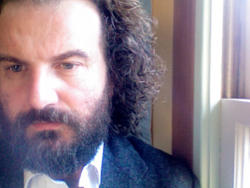Ditch The Narrator
It’s time to get a little bit personal. This week I’m going to write about one of my own stories. I had more fun producing this story than any other story I’ve produced.
It’s called People Find the Drum who Need to Find the Drum, and it hails from waaaaay back in the Stanford Storytelling Project’s archives — Hannah Krakauer and I made it in 2008. It’s about a visiting artist at Stanford, John-Carlos Perea, who leads a 10 week course on pow wow music. He teaches his students the history of pow wow music and dance, then how to play the drum and sing pow wow music. We followed the course for several weeks, and witnessed the transformation that the students underwent during this time.
In the process of scripting this story, Hannah and I scratched our heads and labored intensely over how to tell the story of Perea and the students we’d interviewed. We sorted and resorted our piles of transcripts, and went through several writes and rewrites of the story’s narration. And then, one evening at my house, over our tenth cup of tea, it dawned on us: this story was best without a narrator. The characters could tell their story themselves.
Our narrator was just getting in the way. She felt like a woman in a white coat, observing the the facts, but not affected. The third-person perspective was subtracting from the story’s emotional immediacy.
The decision came when we realized that all of Perea’s students were telling different versions of the same story, and that Perea’s interview and music could be used to weave the students’ perspectives together. It was one of those moments where we both leaned in and raised our eyebrows. Deciding to switch to a non-narrated story, we poured an eleventh cup of tea and stayed up until three in the morning to finish the piece.
Storytelling guides will tell you to decide early in your production process whether to use a narrator or not. When we gathered the audio material, we hadn’t been planning on making a narrator-less story, but by a couple strokes of luck, it worked out.
Here’s why:
-
We asked our interviewees to introduce themselves (Around 9 min, one character appears who does not introduce himself. This is Ben Burdick. Sorry Ben!). Then we asked them to share a little bit about themselves. That way a narrator didn’t have to relay this basic information for us.
-
We asked all of our interviewees the same list of questions, and were surprised at how similar their answers were. This made it relatively easy for us to weave a variety of perspectives together along a single narrative arc.
-
We weren’t afraid of having too much material to work with. We had hours and hours of raw tape for this piece, which made it possible for us to comb through and find the logical connections we needed in order to create a seamless, coherent storyline.
But you don’t have to rely on luck. You can plan all of these things in advance. Because we didn’t plan a narrator-less story in advance, we missed the opportunity to exercise a few more tricks. For example, we didn’t tell the people we interviewed about our plans to not have a narrator. Then we could have asked them to please keep that in mind while they spoke — i.e. to respond to our questions in full sentences. And we didn’t ask our characters to describe where they were, what was happening, and what things looked like. Such sensory details would have developed our scene and grounded our story.
Deciding not to have a narrator presents a puzzle-like challenge that for some producers can be fun. And it can be liberating for your characters, who will speak for themselves.
People Find the Drum who Need to Find the Drum
Produced for the Stanford Storytelling Project by Hannah Krakauer and Bonnie Swift
23 min
{jcomments on}




